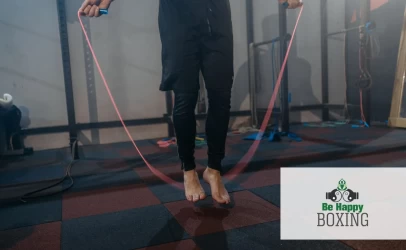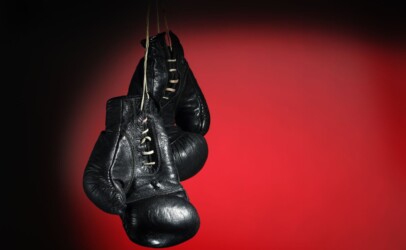Every boxer needs to know the language of the ring. Not only to know what everyone is talking about but also to get familiarized with the terminology and what things mean. This is why we have decided to give you this boxing glossary where you will find terms related to the sport you probably didn’t know their meaning.
We have taken some terms from Title Boxing’s own boxing dictionary, so if you want to see more meanings, head over there!
- Accidental Butt: This occurs when accidentally the heads of two fighters collide. If it is determined that it was an accident and non-intentional, there is no penalization.
- Amateur Boxing: These consist of boxing matches where the participants are not paid, such as the Olympics.
- Apron: There is a section of the boxing ring canvas that extends outside the ring ropes. These are referred to as “apron”.
- Backpedal: When you retreat or move backward from an opponent while still facing him to avoid an attack.
- Be First: This is an instruction from your coach which means that he wants you to throw punches before your opponent does.
- Bell: It is the signal that indicates the start and end of each round.
- Below the Belt: Any punch that stays below the waistband of a boxer’s trunks is referred to as below the belt.
- Bleeder: A boxer who gets cut easily.
- Bob and Weave: These are side to side and rolling movements used for defense.
- Body Work: An offensive method of attack that targets the opponent’s midsection. The intent is to wear him down.
- Bolo Punch: It is a punch that is thrown in a circular motion and used to distract the opponent.
- Bout: A word used to describe a boxing match.
- Brawler: A fighter who likes to exchange punches.
- Break: This is a command used by a boxing referee to separate the fighters.
- Catch-Weight: This is a fight where fighters have not adhered to a traditional weight division but have agreed to a predetermined weight to compete.
- Check Hook: This is a punch that is thrown like a traditional hook but involves simultaneously stepping back and timing the opponent as he comes forward.
- Chief Second: Coach or trainer who is in charge of the corner.
- Clinch: When two fighters grab onto each other to prevent an exchange.
- Combination: Or combos. These are a series of punches thrown in succession.
- Corkscrew Punch: This is a punch thrown in an overhand, arching motion that twists on impact. The intention is to cause a cut.
- Cornerman: This is the person who tends to a fighter between rounds.
- Counterpunch: Any punch that is thrown in return or comes back as a response to an offensive move.
- Cover-Up: This is a defensive move employed by a fighter to avoid getting hit. They will hide behind their gloves to avoid an attack.
- Cross: A power punch that is thrown with the rear hand and travels across the fighter’s body.
- Cruiserweight: This is one of professional boxing’s weight divisions where any boxer that weighs 200 pounds or less can participate.
- Cutting-off-the-Ring: A technique that involves limiting an opponent’s movement by stepping side to side, not allowing him to move freely around the ring.
- Dive: This is when one fighter purposely goes down for the count or pretends to be knocked out.
- Down and Out: This is when a boxer is knocked down and fails to get up before the referee counts to ten.
- Draw: This occurs when the rounds are scored so close that no winner is declared.
- Duck: Dropping your weight down and under a punch to avoid being hit by it.
- Eight Count: A referee will count to eight when a fighter is knocked down. This is to give him time to recover.
- Enswell: This is a tool to reduce swelling and stop bleeding if someone gets cut during a fight. It is made of stainless steel, cooled on ice and applied with pressure on the injured area to slow blood flow.
- Faded: This is a fighter who is not performing at his best anymore and runs out of energy after the second round.
- Feint: This consists of doing a fake punch to get the opponent off his game.
- Flash Knockdown: This describes a quick knockdown where there is no significant damage.
- Foul: A foul occurs when a fighter breaks the rules in boxing.
- Fringe Contender: A low-ranking fighter that is not much of a threat.
- Gatekeeper: A fighter that is not a threat to become a champion.
- Glass Jaw: This is a fighter that gets knocked out easily.
- Groin Protector: A protective gear that is typically made of fabric and foam and fits around a fighter’s waist to protect his hips, upper abdomen and groin area against punches.
- Hand Wraps: These are worn on the hands and wrists to protect them when training and fighting.
- Haymaker: A punch that is thrown with full force out of desperation with the intent to knock the opponent down.
- Head Butt: When two fighter’s heads collide or come together.
- Head Hunting: This is a boxer who focuses on striking his opponent in the head and face and ignores body punching.
- Heavyweight: This is another professional boxing competition where fighters are over 200 lbs.
- Hook: A punch thrown with the lead or front hand and is delivered in a semi-circular pattern.
- Infighting: This is a fight where close-range punches are exchanged.
- Jab: The jab is a punch that is thrown with your front hand and delivered straight at your opponent.
- Knockdown: When an opponent is struck and falls to the ring floor. It also occurs when his glove or knee touches the canvas after being hit.
- Knockout/KO: This is when a fighter is rendered unconscious and is unable to continue fighting.
- Lead Right: A lead right is delivered in place of a lead jab, but is harder to execute because it has to travel across the distance of a fighter’s body to land, so it has to be thrown quickly and catch an opponent off-guard.
- Light Flyweight: A professional boxing competition where any boxer weighing 108 lbs. or less can compete in.
- Light Heavyweight: Professional boxing competition where those who weight 175 lbs. or less can compete in.
- Light Middleweight: Another professional boxing competition where any boxer weighing 154 lbs. or less can compete in.
- Light Welterweight: Professional boxing competition where boxers weighing 140 lbs. or less can compete in.
- Lineal Champion: This is the boxer who wins a title directly from the fighter who had won it before him.
- Low Blow: This is any punch that is thrown or strays below the waistband of a boxer’s trunks. It is considered illegal.
- Mauler: This describes a fighter that likes to fight wildly and use rough tactics.
- Middleweight: A professional boxing competition where any boxer weighing 160 lbs. or less can compete in.
- Minimumweight: Any boxer weighing 105 lbs. or less can compete in this category.
- Mouse: A bump or isolated area of swelling on a fighter’s face.
- Mouth Guard: This is a very important piece of protective equipment that is constructed of a dense rubber material, molded to a fighter’s mouth to protect his teeth, gums and jaw from injury.
- Neutral Corner: Each fighter is assigned a corner: blue or red. The remaining two are neutral and are where they are sent to if he knocked the opponent down.
- No-Decision: When it has been pre-determined by both fighters that a particular fight will not go on their records.
- On the Ropes: Whether purposely, as a defensive technique, or he is forced to fight from this position by a more aggressive opponent, a fighter who lays against the ring ropes is considered “on the ropes.”
- Orthodox: A right-handed fighter or one who leads with a left jab and uses his back, or right hand, as his cross.
- Outpoint: This occurs when a boxer outscores his opponent by landing more punches each round.
- Outside Fighter: Boxers who prefer to fight from the outside, typically behind a long jab.
- Overhand: A punch that is delivered in an arching motion, traveling downward on the opponent.
- Parry: This is when you not block an incoming punch and also re-direct it away from your body.
- Paw: When you don’t fully commit to a punch and throw it without any real intent to land. It can also be a test.
- Peek-A-Boo: It is a fighting style where the hands are placed high in front of the face, providing a lot of angles to confuse the opponent.
- Picking-off Punches: A term used when punches are blocked or redirected before they land.
- Play Possum: This is when a fighter acts like he is hurt or tired in an attempt to lure his opponent in and carelessly leave himself open.
- Plodder: A heavy-footed, slow fighter who consistently moves forward.
- Pound-for-Pound: This is a term used to describe a fighter’s skill level regardless of the weight category.
- Pull: A defensive move where a fighter leans away from or pulls back from to avoid being hit.
- Pull Counter: This is a type of defensive-counterpunch combination used against a fighter who takes the lead and throws a jab first.
- Pull Your Punches: When a punch is not delivered at full force but held back.
- Punch Mitts: A pair of foam pads that a boxing trainer wears on his hands to provide moving targets for his boxer.
- Rabbit Punch: This is any punch that is delivered to the back of another fighter’s head. It is an illegal blow.
- Ringside: A position in the front row or right next to the boxing ring.
- Roadwork: This term applies to running, jogging or sprinting that fighters do in cardiovascular preparation for a boxing match.
- Roll with the Punches: The ability to move with a punch to reduce its impact.
- Rope-a-Dope: When you maintain a defensive posture on the ropes in an attempt to outlast or tire your opponent.
- Roughhousing: When an opponent uses questionable and rough offensive tactics.
- Rubber Match: When two fighters have fought twice, each having won one of the previous matches and this third fight will decide who is the best.
- Shadow Boxing: A type of training or warm-up exercise used to describe when a fighter observes his shadow or his reflection in a mirror, against an imaginary opponent, in order to review his technique.
- Shifting: An offensive technique where you change your lead foot, shifting your weight to gain more power.
- Shoe Shine: A series of flashy punches in quick succession that look impressive but do little damage.
- Shopworn: This refers to a fighter who has taken too much punishment or suffered too much wear and tear on his body over the course of his career.
- Shoulder Roll: A defensive move where a fighter leaves his front arm low and drapes it across his midsection so that when his opponent throws a punch he can use his shoulder to block or roll with it.
- Slip: When you move your head to avoid getting hit.
- Southpaw: A left-handed fighter or someone who is left hand dominant.
- Spar: This is used for training and preparation in the gym where you train against an opponent.
- Spit Bucket: The bucket or container a corner uses to carry their supplies but is primarily used between rounds for the fighter to spit excess water.
- Stablemate: When two fighters train in the same gym and fight for the same manager or promoter.
- Stick and Move: This is an offensive style of fighting that incorporates a great deal of movement, punching and moving constantly.
- Stylist: This is a fighter who uses skill and technique more than power.
- Sucker Punch: A punch thrown at an unsuspecting victim or after the bell has sounded.
- Super Middleweight: Any boxer weighing 168 lbs. or less can compete in this weight division.
- Technical Decision: When a fight is stopped early due to a cut or disqualification.
- Technical Draw: When a bout is stopped early and the scores are even.
- Technical Knockout: A technical knockout, or TKO, is the ending of a fight, determined by the referee, because of one of the fighter’s inability to continue.
- Throw in the Towel: When a fighter’s corner tosses a towel into the ring in order to stop the fight. It is a sign of surrendering.
- Toe-to-Toe: When two fighters don’t back down, stand directly in front of each other and exchange punches.
- Trial Horse: This refers to a fighter who is used as a test for an up-and-coming fighter to gauge his ability or readiness to step-up in class. It is usually a tough fighter.
- Tying-Up: A type of defensive technique used when a fighter clinches or locks his opponent’s arms against his body so that they cannot throw punches in return.
- Uppercut: A punch thrown in an upward fashion, up the middle of a fighter’s guard, intended to make an impact on the point of his chin.
- Weight Class: These are the professional division in boxing that are divided according to their weight.
- Welterweight: A professional boxing where any boxer can weigh 140lbs. or less.
Did we miss one of the boxing terms you were looking for? Teel us in the comments below and we’ll add it to the list! Also, don’t forget to read our last list of our favorite boxing idols of all time!





